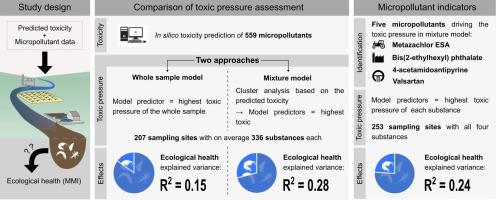使用基于人工智能的毒性预测连接微污染物混合物和大型无脊椎动物生态健康
IF 11.3
1区 环境科学与生态学
Q1 ENGINEERING, ENVIRONMENTAL
引用次数: 0
摘要
本研究将生态毒理学预测与大型无脊椎动物和水化学数据相结合,探讨微污染物混合物如何影响底栖大型无脊椎动物群落的生态健康。使用基于人工智能的TRIDENT模型,我们预测了559种微污染物的毒性(EC10)。通过聚类分析,根据物质的EC10进行分组。在207个采样点,采用两种方法对微污染物的毒性压力进行beta回归评价,以多指标指数为代表,评价了微污染物对生态健康的影响。第一个模型将整个水样的最大毒性压力作为单一解释变量。第二个模型将每个集群的最大毒性压力作为单独的解释变量,与另一个模型(伪r平方= 0.15)相比,它更好地解释了污染对多指标的影响(伪r平方= 0.28)。此外,我们还确定了驱动样品有毒压力的物质。另一个beta回归表明,大部分社区的健康状况(伪r平方= 0.24)可以单独用四种指标物质来解释。我们的研究结果表明,微污染物污染在水生生态系统的退化中起着关键作用,将微污染物的混合物总结为单一物质指标低估了这一贡献。本文章由计算机程序翻译,如有差异,请以英文原文为准。

Linking Micropollutant Mixtures and Macroinvertebrate Ecological Health Using AI-Based Toxicity Predictions
This study investigates how micropollutant mixtures affect the ecological health of benthic macroinvertebrate communities by combining ecotoxicological predictions with macroinvertebrates and water chemistry data. Using the AI-based model TRIDENT, we predicted the toxicity (EC10) of 559 micropollutants. Substances were grouped according to their EC10 through a cluster analysis. The micropollutants’ effects on the ecological health, represented by the multimetric index, was evaluated in 207 sampling sites with beta regressions using two approaches to assess the toxic pressure. The first model considered the maximum toxic pressure of the entire water sample as the single explanatory variable. The second model incorporated the maximum toxic pressure of every cluster as separate explanatory variables, and translated better the effects of pollution on the multimetric index (pseudo R-squared = 0.28) compared to the other model (pseudo R-squared = 0.15). Additionally, we identified substances that drove the toxic pressure of our samples. Another beta regression showed that a large amount of the communities’ health (pseudo R-squared = 0.24) could be explained by four indicator substances alone. Our findings reveal that micropollutant contamination plays a key role in the degradation of aquatic ecosystems, and that summarizing a mixture of micropollutants to a single-substance metric underestimates this contribution.
求助全文
通过发布文献求助,成功后即可免费获取论文全文。
去求助
来源期刊

Journal of Hazardous Materials
工程技术-工程:环境
CiteScore
25.40
自引率
5.90%
发文量
3059
审稿时长
58 days
期刊介绍:
The Journal of Hazardous Materials serves as a global platform for promoting cutting-edge research in the field of Environmental Science and Engineering. Our publication features a wide range of articles, including full-length research papers, review articles, and perspectives, with the aim of enhancing our understanding of the dangers and risks associated with various materials concerning public health and the environment. It is important to note that the term "environmental contaminants" refers specifically to substances that pose hazardous effects through contamination, while excluding those that do not have such impacts on the environment or human health. Moreover, we emphasize the distinction between wastes and hazardous materials in order to provide further clarity on the scope of the journal. We have a keen interest in exploring specific compounds and microbial agents that have adverse effects on the environment.
 求助内容:
求助内容: 应助结果提醒方式:
应助结果提醒方式:


